Treasury, an ideal candidate for S/4HANA Central Finance deployments
Key takeaways:
- SAP’s Central Finance (CFIN) increasingly being seen as the optimal way to deploy and de-risk ambitious S/4 finance transformations at global organisations
- Corporate treasuries, naturally thriving in centralisation, seem to have found a perfect match in those complex, CFIN-powered S/4 transformations
- Done right, the build of treasury & cash management processes on top of CFIN, while capable of scoring some early wins for projects stakeholders, can open up new ways of doing business for treasury staff and senior executives
- Please note: The terms CFIN and Central Finance will be used interchangeably here. The purpose of this post is to present opportunities for treasury management in the current S/4 finance market. This not a CFIN guide.
Global SAP Treasury architectures. Where we are now.
As the COVID-19 pandemic brings us into a new period of risk and uncertainty, we tend to draw lessons from the recent past. The 2008 financial crisis turned the spotlight on effective risk and cash management. Corporate treasury gained further recognition and its strategic role was acknowledged and applauded. However, the implementation of technology required to support this role has not always been ideal. The technology is available, but ERP landscapes, becoming more and more complex over the years, have left little room to seamlessly integrate any new functionality. Fragmented systems architectures and inefficient local processes have turned liquidity reporting into a challenging task, while global risk management remains a daunting, largely manual, exercise. Today’s realities mean all that complexity and disparity have to be urgently addressed, and resilience against multiple types of risk must be well embedded into treasury processes and systems architectures.
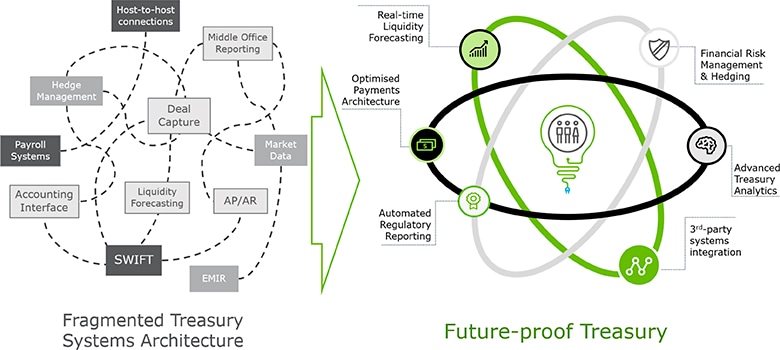
A new dawn for SAP Treasury?
As multinational organisations explore possible roadmaps of finance transformation, Central Finance comes up as an attractive option to achieve an earlier return on the S/4 investment. This option involves the early deployment of an S/4HANA Central Finance layer, on top of the existing multi-ERP architecture. A first key function of this central layer is to start pulling and consolidating financial information from the existing (a.k.a the “legacy”, as your IT will tell you) systems landscape, in real-time. And it will start doing so while the rest of the organisation is preparing to transform its finance systems from the ground up. But since this roadmap type has been gaining momentum in the market, another question arose: If you succeed in introducing such a powerful financial technology into production, why stopping in reporting? There must be more in transforming finance.
Enter corporate treasury
Treasurers who have been aiming for a tighter centralisation of their function for years, are finding themselves in a unique position. Enterprise programmes involving an early go-live of a centralised technology layer, are turning corporate treasuries into ideal candidates for the first phase of S/4 finance transformations. For a group treasury department, CFIN’s functionality of collecting and processing data can be a treasure chest of information (pun intended). And that does not mean we are just creating another data lake. For a specialized finance function such as the corporate treasury, CFIN can be a business processes powerhouse, driving further efficiencies in operations and reporting.
Treasury Management processes built on top of a Central Finance layer

How Treasury benefits from S/4 Central Finance
Corporate treasury, from a technology point of view, consumes financial data recorded within the organisation, and combines them with market information to generate strategic intelligence and drive tactical decision making. For example, a vendor invoice recorded in a subsidiary’s system, perhaps somewhere on another continent, the electronic bank statement used to reconcile the open item and the exchange rate of the value date, are key information components required by treasury to perform its tasks. These tasks may include the generation of cash position and risk exposure reports, as well as taking decisions on intercompany netting or funds allocation. Besides the technical benefits of having an integrated platform (think fewer points of failure for example) which are not the focus of this post, the direct CFIN impact on data-driven treasury insights is two-fold:
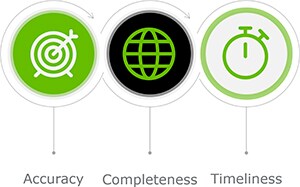
Completeness & accuracy: Group treasury users, will not only enjoy easy access to the full picture of their global liquidity and exposures, but they will also be able to drill back to the primary source of the original document and identify the business event which affected their position. Reconciliation is not an externally triggered process, it is embedded.
Timeliness: Central Finance can push real-time cash flow information into the group treasury management system database tables. Of course, some treasurers might - reasonably - scoff at the real-time hype. But let’s look through the noise of the heated debate around the value (or lack thereof) of real-time data for treasury. Building cash management on CFIN-powered instances means that liquidity reporting will no longer be bound by slow interfaces and complex databases, and that the newly deployed infrastructure will be able to support the brave new world of cash management, with APIs exchanging and consuming information, and RPA bots paying delighted vendors as fast as possible after the necessary – automated of course - checks.
Which corporate treasury processes are ripe
Two key corporate treasury process areas are immediately reaping the benefits of S/4HANA Central Finance. The first one includes cash positioning and liquidity forecasting processes. The real-time replication of payables and receivables (AP/AR) from the source systems into the central treasury layer, assisted by the recent overhaul of the S/4 Cash Management data architecture, drives further gains towards the efficiency and flexibility liquidity forecasting. New S/4 apps, from actual vs forecasted to cash pooling, are leveraging this technology, and offer a more dynamic way of reporting and transacting in treasury management. Static developments from older SAP versions look more and more like a thing from the past (which, admittedly, they are).
The second process area to directly benefit from a CFIN deployment is financial risk management. The aggregation capabilities of Central Finance automate and streamline the identification of foreign currency exposures across business units, enabling treasurers and CFOs make more informed decisions on FX risk mitigation. As a result, firms can achieve higher returns on capital, while optimising borrowing costs effectively at a global level.
S/4HANA Central Finance as the powerhouse of key Global Treasury Management processes
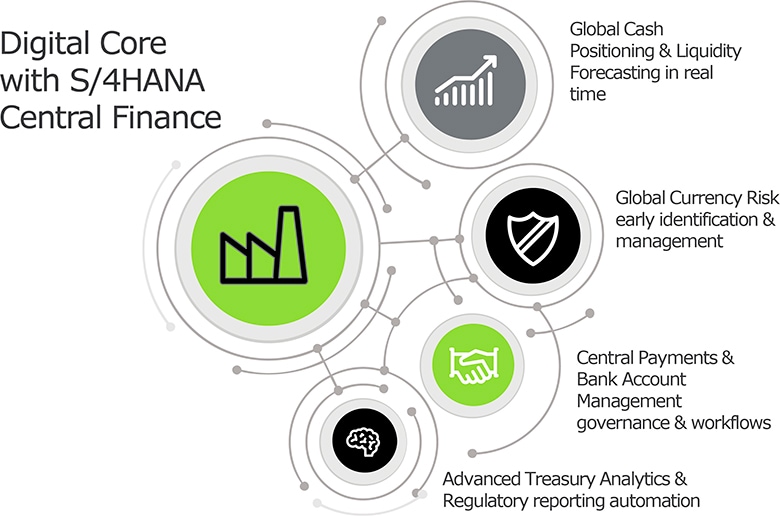
Central Finance can deliver immediate benefits to corporate treasury management, as we saw above. Moreover, by opting for that route on S/4 finance transformations, several additional corporate treasury processes, such as payments and bank account management, can also benefit from the integrated environment created. That will be the focus of another post, but as we said, CFIN can set the stage for new ways of doing business in treasury management.
How to make it a success: practical steps
1. Review treasury-related source data and processes
Data mapping plays a critical part in all finance transformations, and treasury needs to be involved from the early phase.
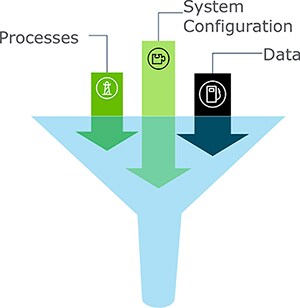
As a project stakeholder, you will also need to ensure that processes in the source systems are well-defined, understood and followed. This exercise at the business process level complements the data cleansing and harmonisation activities, which happen at the technology level in finance transformation programmes. Remember that, ultimately, the quality of the centralised treasury reporting depends on the source processes, where it is crucial to implement and enforce best practices on payments and collections - just a fancier way of saying “garbage in, garbage out”.
2. Design a clever deployment plan
Deployment plans are of course depended on project specifics. A non-disruptive introduction of S/4HANA Central Finance for corporate treasury would, in most cases, involve the delivery of a liquidity reporting layer alongside improved governance in areas such as bank account management (BAM). Moving forward, treasury can deploy more functionality on the central finance instance and use it not only as a reporting layer but as a transactional hub. As we said, the often centralised nature of treasury makes this environment an ideal landscape. A range of treasury processes from POBO, PINO, and cash pooling to hedge management, EMIR reporting, and bonds issuance can be centrally deployed on CFIN making the most of all the latest and greatest S/4 capabilities. Central Finance technical deployment should precede any cutover of the S/4 Treasury functionality, to allow time to test the database’s resilience and verify its good functioning before the business go-live.
Key Treasury and Cash Management functionality roll-out per programme phase, during CFIN-powered S/4 Finance Transformations
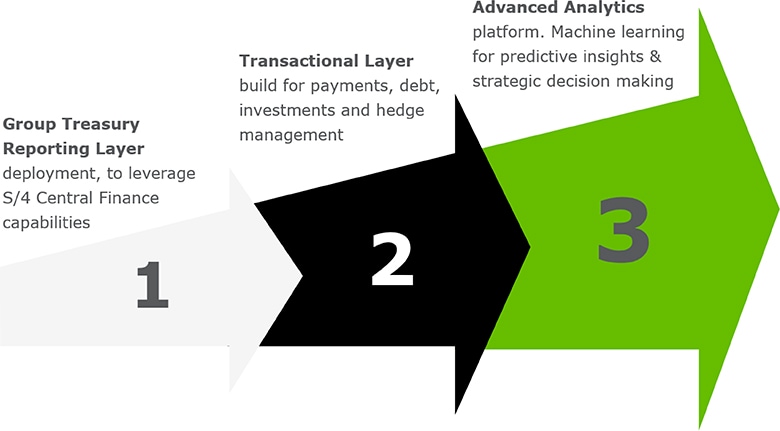
3. Create a vision for the Treasury end-state architecture
All of the steps outlined above must be part of a bold, yet realistic and unambiguous vision for the treasury systems to-be architecture. Decide what level of process centralisation is required, what third party systems will be needed to complete the S/4HANA picture, agree within your organisation where banking signatories and controls should be, and even raise some more difficult questions, such as whether your risk management policy is still valid in the new threats landscape. S/4 and CFIN will not solve all Treasury problems. However, combined with a thorough and well-thought plan for business transformation, they can be a major accelerator towards Treasury meeting its well-analysed and anticipated strategic role.
Recommended articles
Contacts


